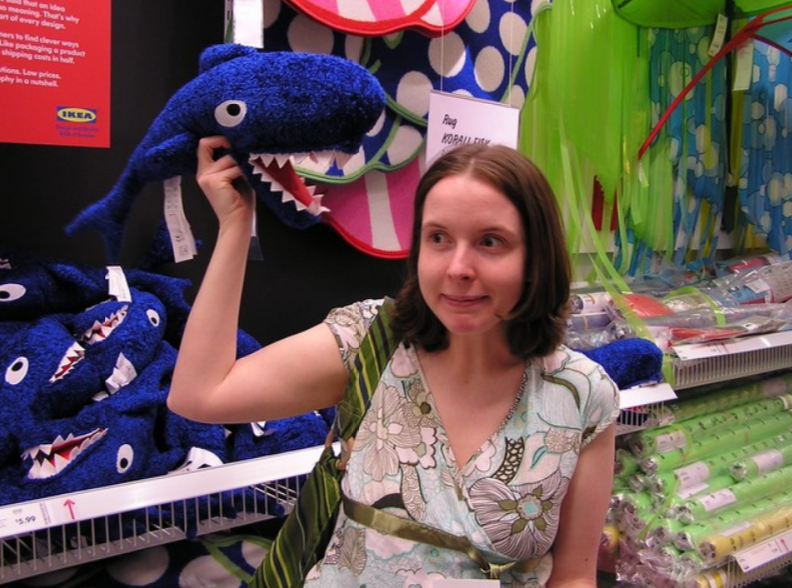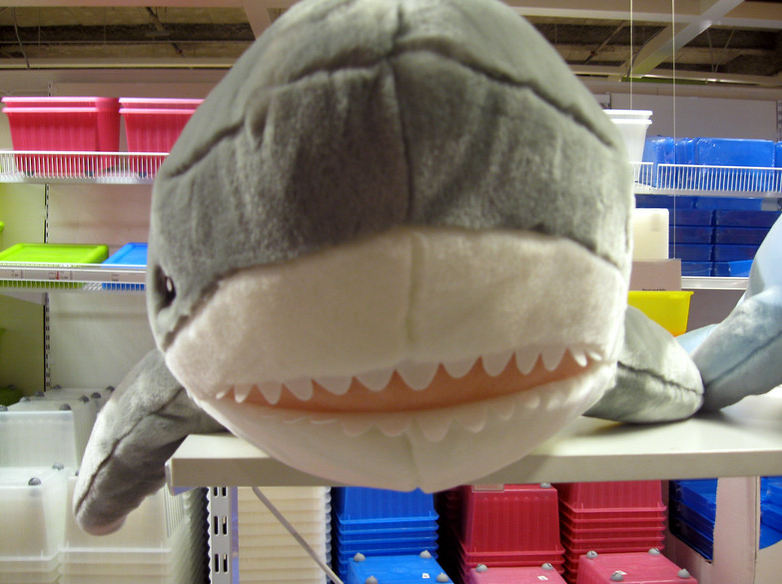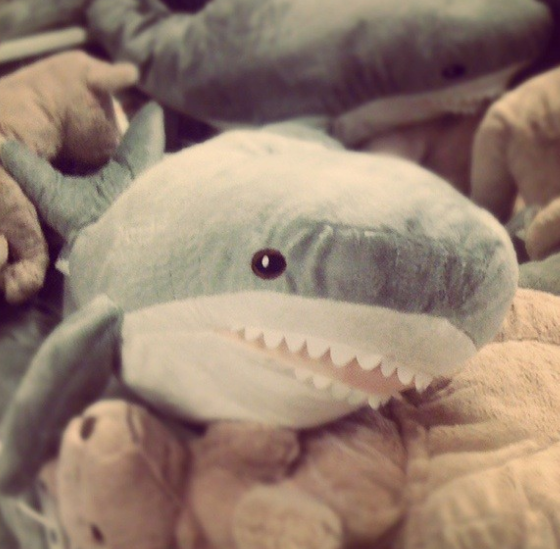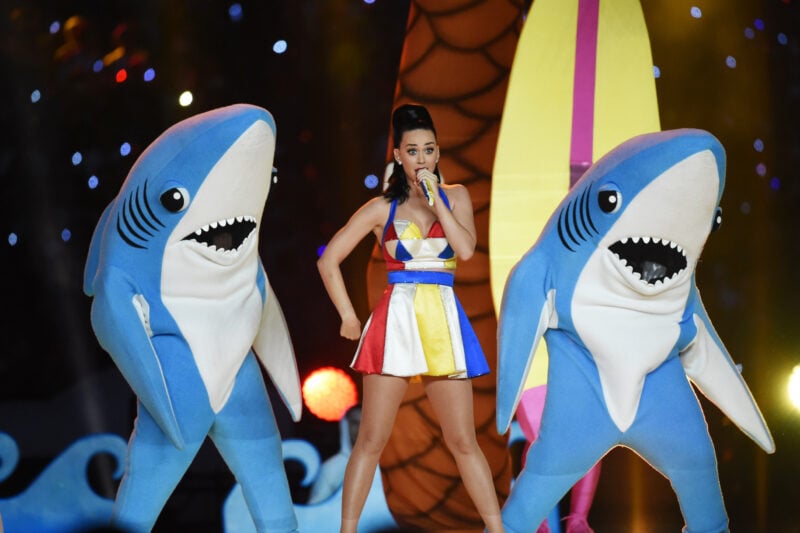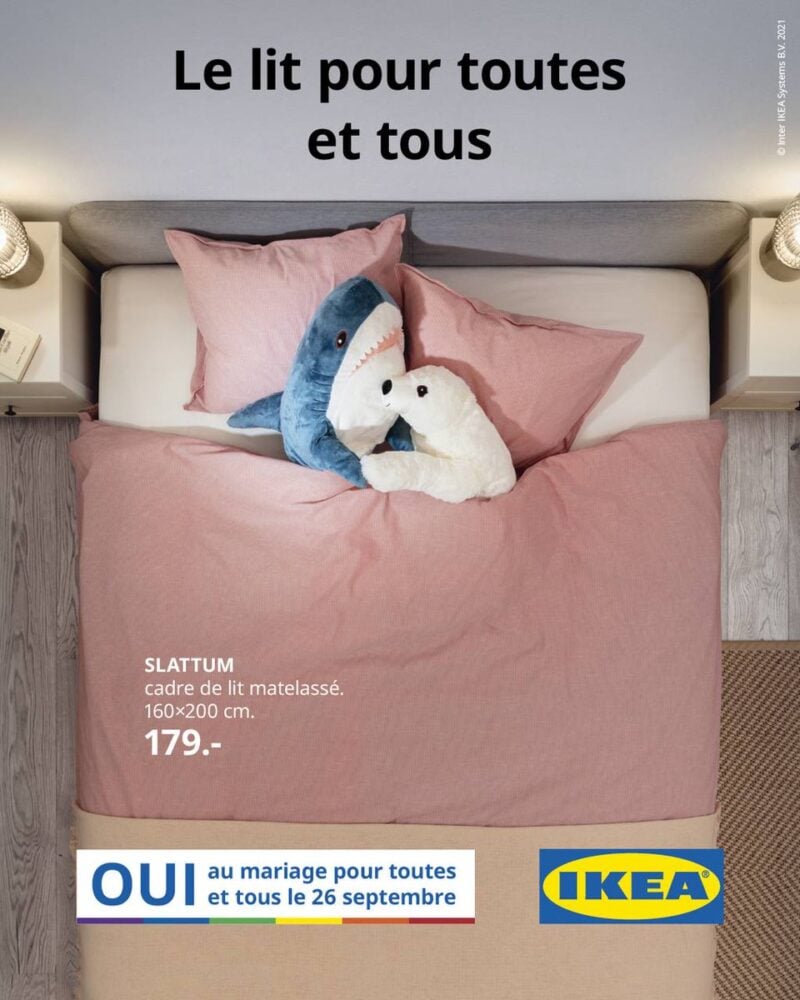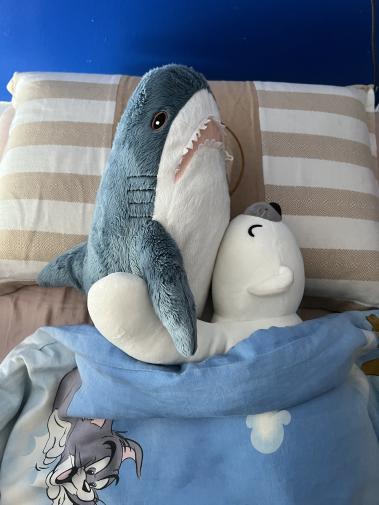
BLÅHAJ: the Internet meme, the trans icon, the world’s favorite plush by Audrey C. '24
media analysis on the Swedish shark’s rise to prominence
*puts on CMS hat* I LOVE watching media analysis video essays. Whenever I finish a relatively mainstream series (ex. The Owl House, The Hunger Games, Avatar the Last Airbender), I spend hours watching nearly every video essay that exists on Youtube, dissecting the underlying commentary, allegories, plot devices, etc. I emerge with a deeper understanding of the content and a deeper appreciation for the creators. But even if the discussion is on media that I don’t personally consume (ex. family vloggers, the Kardashians, Mr. Beast), I find the social, cultural, political, and economic forces that enabled these influencers’ rise to prominence to be SO interesting. Perhaps one day I’ll join the ranks of video essayists, as I believe video essays to be the most digestible and accessible form of media studies content. Unfortunately I hate video editing, so for now enjoy this Blahaj blog :).
Blahaj, Swedish for “blue shark,” is the cuddly plush that many of us know and love. Blahaj’s wide pink smile is lined with white triangles of felt teeth. Blahaj’s brown eyes are embroidered on, as Blahaj’s retailer Ikea noticed that beaded eyes pose a choking hazard to young children. Blahaj is a meter long, nearly body pillow sized. When you hold Blahaj, Blahaj doesn’t judge, Blahaj simply understands.
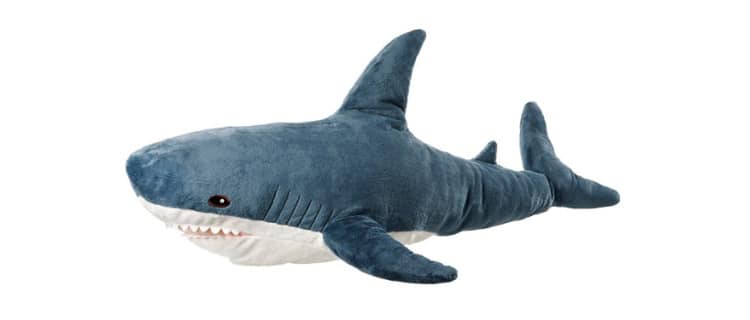
While the adoration of Blahaj is a worldwide phenomenon, the impact of Blahaj on people and communities can be seen and felt right at home. Indeed, Blahaj has recently inserted themselves into many facets of MIT student culture. Blahaj has become a spinning prop for Jonathan ‘25 to perform what’s called a holy trinity, a move usually done with a staff:

this is so impressive holy moly (video courtesy of Jonathan ’25)
Blahaj had their own Friday Afternoon Club (FAC) at East Campus last November, where an assortment of shark related snacks were passed out.
Are you a Blahaj enjoyer? Do you have a baby who wants to meet new shork friends? Maybe you just want to see some sharks and eat shark food (shark shaped or for sharks??? )? Come to Blahaj FAC tomorrow at 5 pm in Talbot!
Rory ‘24 runs a recurring event called Sharkcuterie at Random Hall that brings Randomites and their Blahajs together to feast on cheese, crackers, and fancy drinks.

blahaj and friends! (photo courtesy of Rory ’24)
Blahaj is the unofficially official mascot of MIT Sport Taekwondo. But while Blahaj has achieved local celebrity status by posing in every other East Coast Taekwondo Collegiate League teams’ photos, Blahaj isn’t only there to look pretty. Under the care of club officer Tiffany ’24, Blahaj trains regularly with the team and has become an accomplished martial artist in their own right.

Blahaj in sparring gear! photo courtesy of Tiffany ’24
But how did this shark plush get so popular? Blahaj’s rise to Internet and cultural stardom did not happen overnight. Instead, Blahaj has maintained a steady Internet prominence since its release in 2014. While there is always an element of chance to what does and does not go viral, I argue in this blog that Blahaj’s popularity can be contextualized within multiple broader forces of the past decade, such as Internet meme culture, the pandemic, and the protection and dismantling of LGBTQ+ rights. As an unsuspecting symbol of quiet resilience, Blahaj has emerged as the constant source of comfort that the world can hold onto during this period of instability.
Early Evolutionary History
Reddit users traced the first ever shark introduced by Ikea, the Korall Fisk, to a picture taken in 2006. Then in 2008, Ikea released the Grossby, a gray shark that looks similar to Blahaj but has a different plush fur texture. The Grossby evolved into the Klapper Haj circa 2010, who is nearly identical with Blahaj except for the color.
Finally, Ikea introduced the Blahaj that we know today in early 2014. Between now and then, Blahaj has only gone through minor revisions like reducing the number of gills from 6 to 5. The blue shark quickly became a staple of the Ikea plush oeuvre, catapulting into Internet memedom and into our hearts.
The Internet Meme
According to Know Your Meme, the first widely circulated picture of Blahaj surfaced on Tumblr in 2014:
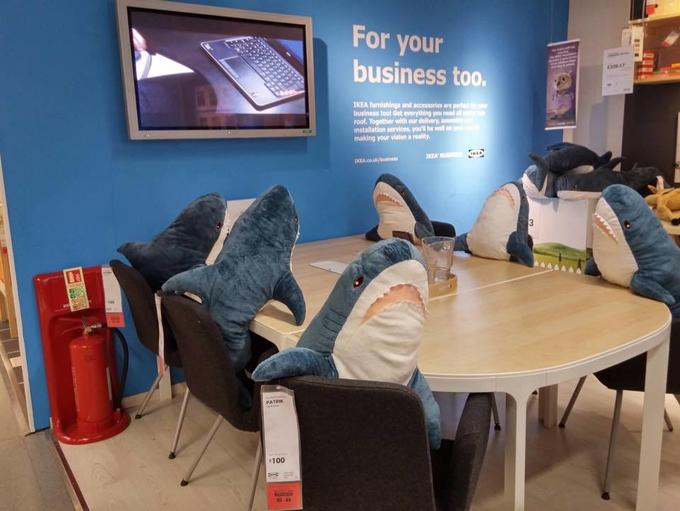
Since then, many more photos of Blahaj being placed in human-like situations circulated on the Internet. Rory and Tiffany’s Blahaj photos follow this meme format. In 2018, similar Blahaj memes exploded in Russia, whose Ikea locations reported running out of Blahaj’s one hour after restock.
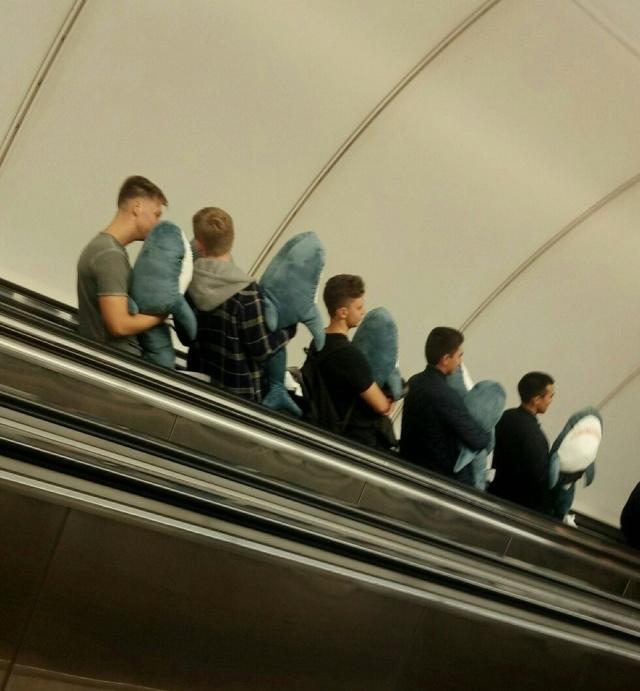
this viral photo was taken at a Moscow location in 2018
Blahaj isn’t the first shark in the meme culture canon, but instead continues a legacy established by Left Shark and Baby Shark. One of Katy Perry’s backup dancers during her 2015 Superbowl halftime show performance, colloquially known as Left Shark, went viral for forgetting the choreography. Aside from messing up on national TV, the laughable awkwardness of the situation is magnified by the dazed expression on the shark onesie and the overall silliness of Katy Perry’s beach themed stage set. Then in 2016, the South Korean company Pinkfong released the Baby Shark nursery song. As the Baby Shark challenge went viral first in Indonesia and later other parts of the world, the Baby Shark song skyrocketed in streams to the point where it reached #32 on the Billboard 100.
What Left Shark, Baby Shark, and Blahaj have in common is that they all disrupt the norm of how sharks are portrayed in the media. Sharks have a reputation of being vicious killer beasts, thanks to sensationalized reports of shark attacks and the Jaws franchise, a series of films focused on sharks eating innocent beachgoers. However, our three meme sharks are anything but threatening. Left Shark is awkward and silly. Baby Shark is cute and promotes intergenerational family relationships. Blahaj’s listing on Ikea claims that they are “Big and safe to have by your side if you want to discover the world below the surface of the ocean.”
The virality of cute shark imagery isn’t surprising when considered in the broader context of memes. We share things that make us feel good, make us laugh, and especially in the case of our three meme sharks, subvert our expectations. But perhaps most important to how and why memes propagate like wildfire, memes foster participatory cultures where basically anyone with Internet access can contribute their own version of a meme. By encouraging people to create and share Blahaj photoshoots, Blahaj’s Internet debut does exactly just that.
Comfort during the Pandemic
Google search trends reveal an uptick in searches for Blahaj starting from early 2020, which coincides with the beginning of the Covid-19 pandemic.

Especially during early stages of the pandemic when social distancing regulations and quarantines were enforced, many people experienced increased feelings of isolation and despair. People were touch starved.
If hugging another living thing isn’t possible, the next best thing is hugging a stuffed animal. Blahaj emerged as a popular emotional support plush for its relative accessibility. Blahaj is affordable compared to other plushies of a similar size and is sold by a big box retailer with multiple locations across the US and the world. These two attributes also apply to the Costco Bear, which was popular at a similar magnitude during the pandemic.
Blahaj and the Costco Bear’s pandemic popularity may also be explained by the lipstick effect. This theory states that smaller, less expensive novelty goods (like lipstick) remain popular during economic recessions. While something like a luxury bag might be out of the budget, many consumers can afford lipstick as an indulgent “treat” as a temporary escape from their worries. In other words, “everything’s going to shit, but at least I look hot.” Blahaj plays a similar role where “at least I look hot” becomes “at least I can get a hug from a silly shark.”
While everyone can use Blahaj’s cuddles during these trying times, Blahaj holds special significance for a particular community to the point where Blahaj is without a doubt, an icon.
The Trans Icon
The first picture of Blahaj with a trans flag background surfaced on Reddit in 2020.
![]()
In the past decade, Tumblr and to some extent, Reddit have provided safe spaces for LGBTQ+ people to explore their identities, especially for those living in homes or communities where being out may not be safe. These Internet spaces also serve as hubs of information, empowering people with the language to express their sense of self and with knowledge for what transitioning may look like. Naturally, many inside jokes (like the stereotype that lesbians wear carabiners on their belt loops) emerged in these communities. Such inside jokes contribute to the broader culture, as being a part of the inside joke (like choosing to wear a carabiner to subtly signal being fruity) fosters camaraderie. In a world that villainizes LGBTQ+ people through rhetoric, legislation, and violence, building up these strong Internet communities with their own culture and jokes aligns with the idea of “joy as resistance,” a phrase coined by Black feminist Toi Derricotte.
When Blahaj broke into the Tumblr/Reddit scene, trans communities on those platforms quickly latched onto Blahaj. Writer Meghan Cherry01 highly recommend reading this for a more personal perspective on the importance of blahaj to the transfeminine community, and for more context on how transfeminine internet communities has shaped meme culture as a whole! contrasts Blahaj’s association with the trans community against how middle aged, white women first found Minions to be funny and therefore forged the link between Minion memes and wine moms and conspiracy theories: “Early adoption of a meme incites ownership. Like it or not, the internet’s attention span is a game of first come, first serve. Trans women simply got to BLÅHAJ first.” Having a Blahaj became a stereotype, an inside joke. As a result, more trans people get Blahajs to feel that connection with their community, creating a self reinforcing cycle that propels Blahaj to icon status.

It helps that Ikea has a long history of supporting LGBTQ+ rights in its advertising. People prefer to buy from companies that align with their values, or in this case, support their basic rights. In 1994, Ikea released the first mainstream commercial featuring a gay couple. In 2021, Ikea featured Blahaj and Snuttig the polar bear cuddling together in support of a Swiss referendum on same-sex marriage and adoption rights.
While Blahaj already kind of shares a color palette with the trans flag with its blue body, pink mouth, and white belly, Ikea Canada donated specially designed Beyou Blahaj plushies to the Halifax Sexual Health Center in 2022.
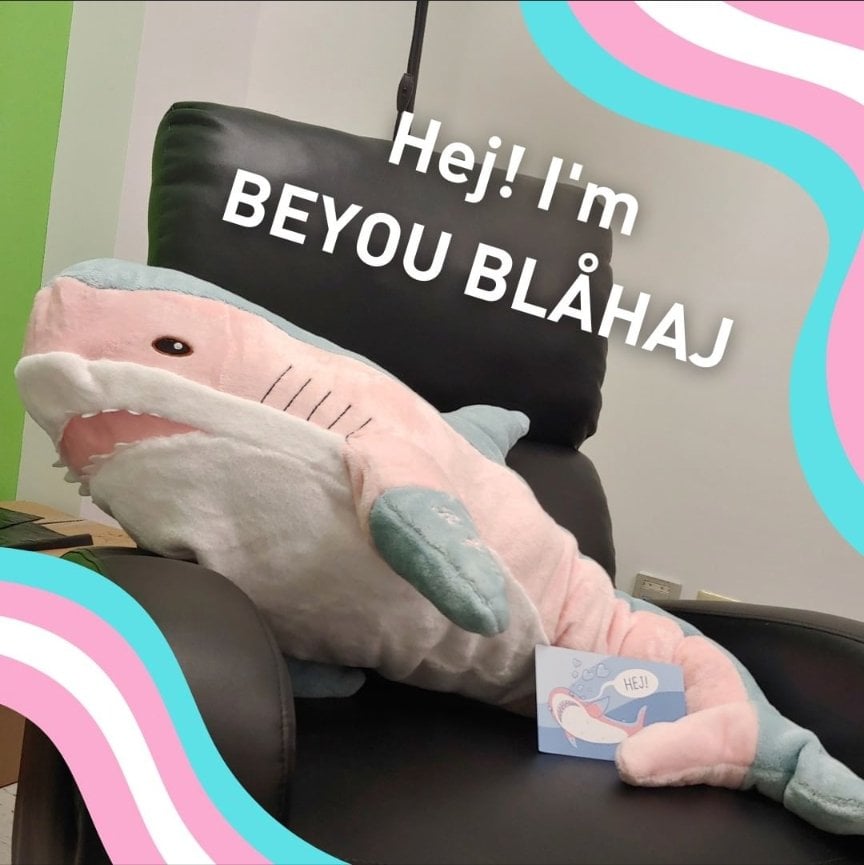
Blahaj’s wide appeal both within and beyond the trans community may also come from the fact that it’s not marketed towards a specific gender, like many clothing or toys featuring sharks are. Going back to the archetype of the killer shark, sharks are often associated with violent masculinity. As a cute plush, Blahaj defies gender norms and thereby allows many trans people to experience and express gender on their own terms.
A Reddit user explains that plushies, Blahaj included, are popular with transfeminine people as a lowkey expression of femininity. A transmasculine reddit user says that they love sharks and other things that 8 year old boys would like. Cherry writes that the trans experience often includes “spen[ding] one’s formative years having the incorrect childhood experiences.” And while Blahaj can’t undo that, Blahaj helps heal the inner child for many trans adults. Unfortunately being a trans child today remains a difficult experience, with the recent onslaught of bills targeting gender affirming care, gender expression at school, and sports participation for trans youth. And while Blahaj won’t singlehandedly bring change, having a Blahaj provides comfort for trans kids while giving them connection to a community that does embrace them for who they are.
Blahaj Loves All
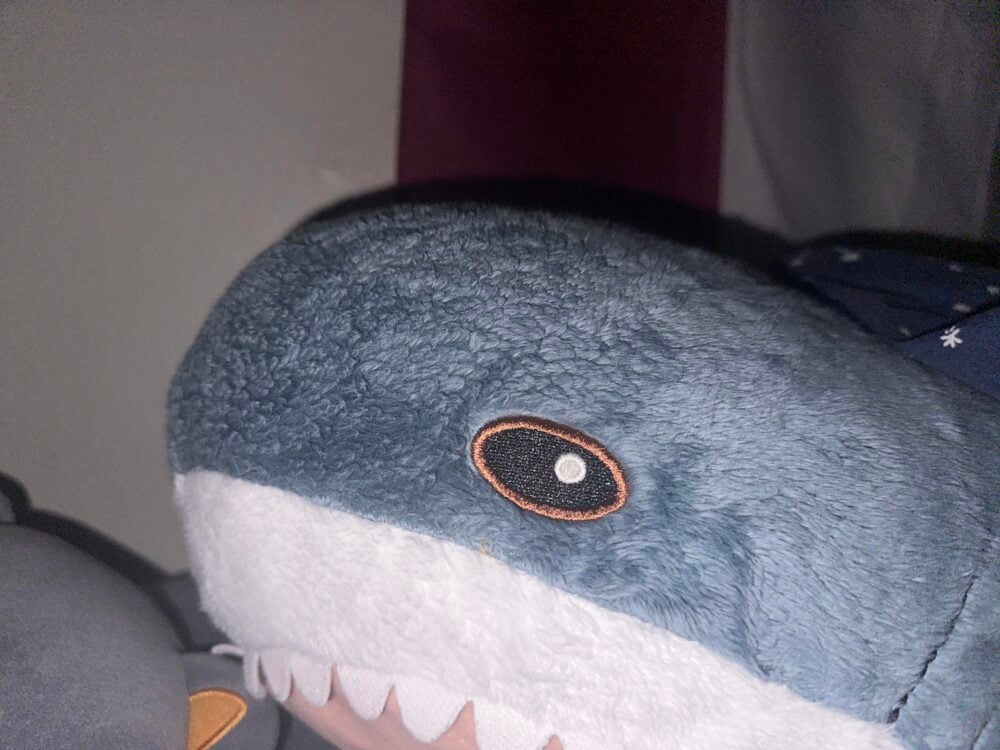
no thoughts head empty (photo courtesy of Tiffany ’24)
Blahaj may appear to possess not a single thought behind those embroidered eyes. But when we consider just how impactful Blahaj has been on all sorts of communities, Blahaj most certainly contains multitudes. As a catalyst for participatory meme culture, antidote to touch-starvedness, advocate for LGBTQ+ rights, symbol of the Internet trans community, and tireless member of the MIT community, Blahaj is loved by all.
And of course, Blahaj loves all.
- highly recommend reading this for a more personal perspective on the importance of blahaj to the transfeminine community, and for more context on how transfeminine internet communities has shaped meme culture as a whole! back to text ↑
